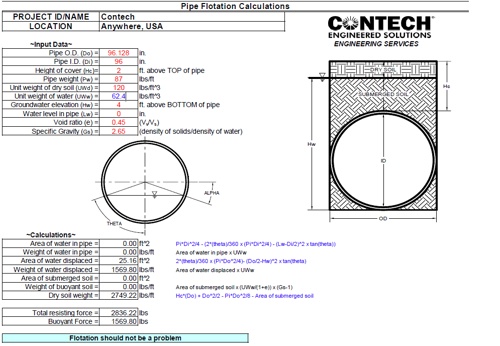
Will it Float? Understanding Stormwater Detention Buoyancy Calculations
One of my favorite summer activities is floating in the water and looking up to the sky. For some, like me, floating can be relaxing, but for others, floating brings an uneasiness. When floating, one must trust the physical force at play – a force known as buoyancy.
When trying to float in the ocean, buoyancy is a good thing. In the case of an underground detention system design, buoyancy is a design consideration that is particularly of concern when groundwater is present. Buoyancy is the tendency of a fluid to exert a supporting upward force on an object partially or entirely submerged in a fluid. A buoyant force on an object is equal to the weight of the displaced fluid. In simple terms, the water keeping me afloat exerts a force equal to the amount of water my body displaces.
If groundwater exists on-site, calculations should be run to determine if the underground detention system will float. The system will not shift if the sum of the resisting (vertical downward) forces are greater than the buoyant (vertical upward) forces.
Step one in determining if buoyant forces exist is to examine the groundwater table elevation. If the groundwater is below the invert of the underground detention system, buoyancy is not a concern. If the groundwater table is above the invert, the system must be checked for flotation. The next step is to calculate the resisting forces. The resisting forces include the following:
• Weight of pipe (or detention structure)
• Weight of soil (dry and saturated)
• Weight of water in the pipe (a conservative approach is to assume the system is empty)
Next, the buoyant force is calculated. The buoyant force equals the area of the water displaced multiplied by the unit weight of water (62.4 lb/ft3). If the resisting forces are greater than the buoyant forces, pipe flotation should not be a problem, and countermeasures are not required. The example below shows all of these calculations.

If the buoyant forces are greater than the resisting forces, countermeasures are necessary to overcome flotation. Here are some methods used to overcome buoyancy:
• Increase soil cover- an increase in soil cover improves the net resisting forces.
• Raise the system invert out of the groundwater table using Variable Diameter CMP Systems, thus removing buoyancy concerns.
• Specify anti-flotation anchors - the underground detention system is anchored to concrete deadman via hold-down straps.
Ignoring buoyant forces may result in the system lifting upward. Buoyancy on the surface is a relatively simple concept, but an important consideration that can complicate the design of an underground detention system on a site with groundwater present.
